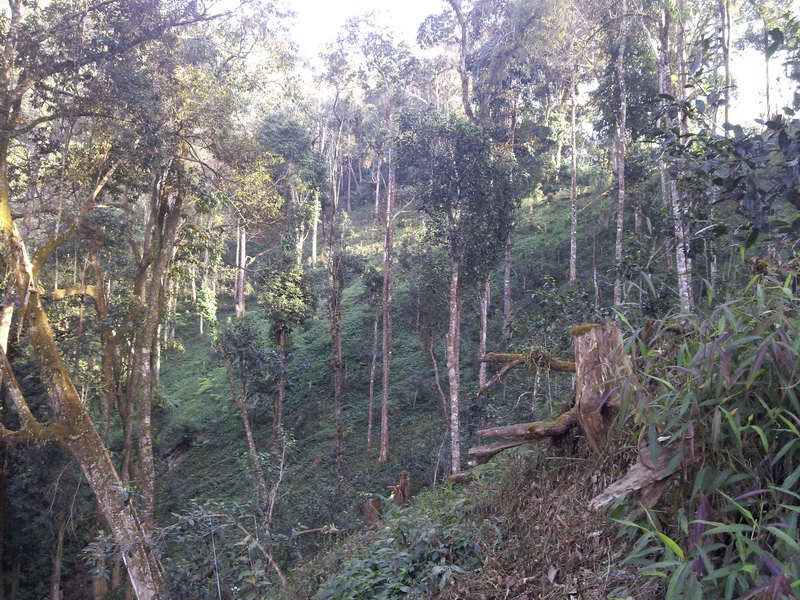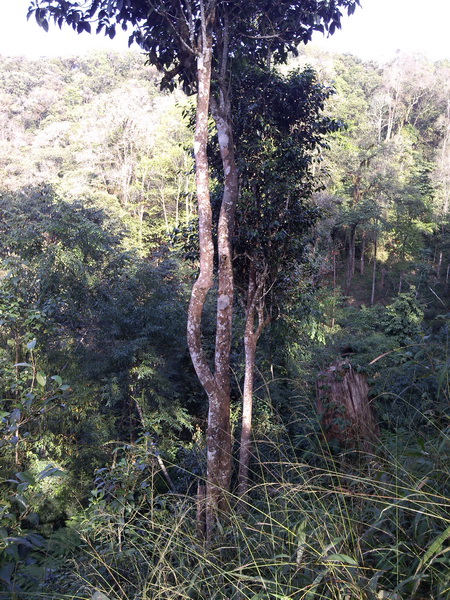Last week, I had a few days’ trip in the SFTM area. The weather was good – dry, warm in the day, cool at night – and I got to re-visit some places and also go to a couple of new places.
I’ve been trying to get to Ma Pia (吗叭/ma ba in Chinese) for a couple of years. I think it was the autumn before last, I was with some friends in Ding Jia Zhai who had just come back from Ma Pia with some tea. One of them had a couple of pictures on his mobile phone. The tea wasn’t up to much – there were some problems with processing – but the trees looked interesting.
As a quick aside, many local place names have two pronunciations. One in a local language and one Han Chinese. Han Chinese has a limited number of sounds, so is not particularly good for replicating the sounds of many other languages. So what one often ends up with is an approximation of a word. New York/纽约/niǔyuē or maybe London/伦敦/lúndūn. If we forget about the tones and just look at the sounds, there is a sound similar to ‘or’ in Chinese, but there is no ‘k’ sound on the end of a word, so York or / jɔ:k/ is not possible, though 纽游客/niǔ yóu kè maybe could have done the job. But it doesn’t sound very nice. 不好听!
Similarly, there is no ‘u’ sound, as in cup /ʌ /, so London or /lʌndɘn/ is also not possible, though, to be fare, it’s a good approximation of a Yorkshire accent. English is of course no better. Anyone remember the old Boddingtons advert with some lads on the Riviera ‘drinking beer in Cannes’? I guess it’s good we can joke about it.
Chinese actually makes a better fist of say Paris, 巴黎/bālǐ than English does, coming closer to the French than English does , if you forget about the whole ‘l’ ‘r’ thing.
The famous Nan Nuo Shan is also an approximation. In the Dai or Thai language ‘nam’ means water or liquid. nam nuo, or something approximating that, was a fermented bamboo sauce that was offered to the Tu Si. But there’s no word in Chinese with ‘m’ at the end, so it becomes nan.
And so it is with Ma Pia. Nobody pronounces it Ma Ba, and even local people have varying tones of the ‘pia’.
Anyway, back to the story……………
Ma Pia is right on the China/Laos border and the easiest way to get there is on a road from Man Nai/曼乃, but if you’re a foreigner, the bian jing won’t let you out, or, they might let you out, but probably won’t let you back in. A couple of people had told me that if someone took me, there would probably be no problem.
It just so happened that when I was there recently, I was introduced to someone who offered to be my host. So we set off on a 20km motorbike ride along small mountain tracks to get to the tea gardens. They are about 10km away from the village ( there are actually two villages: shang and xia)
Typical of many gardens in the area, there’s a mixed bag of trees. In the gardens I visited, there are a few quite big trees – maybe 7-8 metres tall with trunks with girths of 160 cm or so – and many sizeable trees which are clearly quite old, but that have either been cut back at some point or, more likely, have been burned down in underbrush fires. (because Yao people, who are the main guardians of a number of these tea gardens, were not traditionally tea farmers, practicing rather, a mix of hunting and gathering, along with some subsistence agriculture, many of these forest areas have been subject to slash & burn type treatment in the past).
There are also several much smaller trees, many of which have grown naturally, often from the root of an older tree, but there are also some that were undoubtedly planted. That’s not particularly bad, the environment is good and there are no obvious signs that the gardens have been mismanaged (apart from the burning of course!)
My friend from Ding Jia Zhai had shown me a photo of a quite stout tree, doubtless several hundred years old that was in or near the village. These trees are different. They are way up in the mountains, surrounded by forest, so the environment is much better. I don’t know where the tea we had in Ding Jia Zhai was from – near the village, or the tea gardens, but I reckon the area is probably worthy of further investigation.
The tea here, like many such places: Tong Qing He, Gua Feng Zhai, Wan Gong, Bo He Tang, Duo Yi Shu, etc. has seen a big hike in price in the last couple of years, and tea from the single, bigger trees from these tea gardens can go for anything from a couple of thousand to five or six thousand yuan a kilo ($300-600). But that’s the high end, and there’s not much of it, but I’m hoping to at least get my hands on a sample or two to see if the value matches the price.




